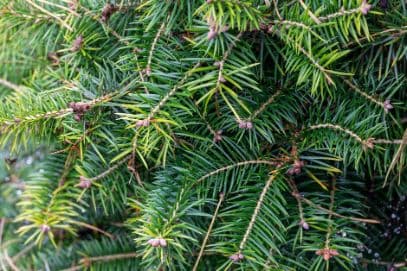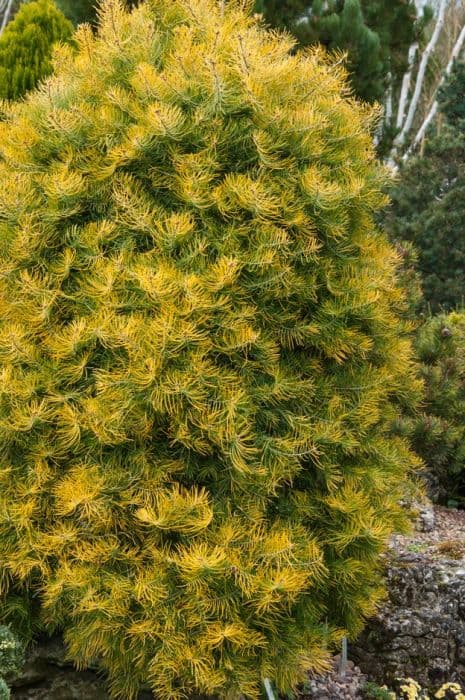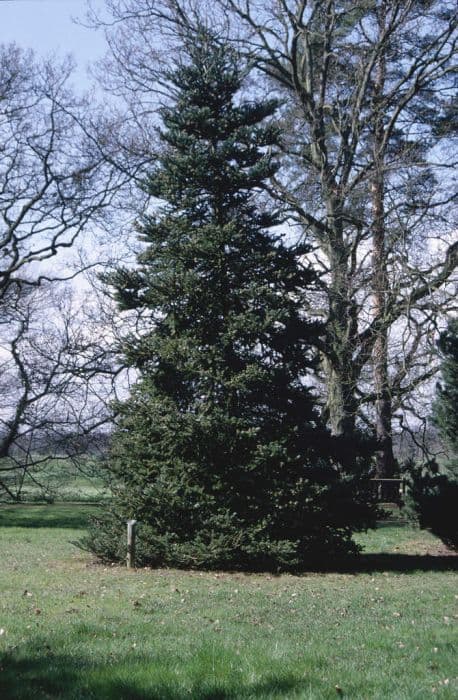Serbian Spruce Picea omorika 'Pendula'

ABOUT
Serbian spruce 'Pendula', a cultivar of Serbian spruce, features a unique and eye-catching appearance. Its main visual characteristic is a narrow, weeping or pendulous form with branches that droop gracefully, creating a dramatic effect. The foliage of the Serbian spruce 'Pendula' is dense and the needles exhibit a striking color palette; they are dark green on the upper side and have a silvery-white to bluish-green underside, which shimmers when the wind brushes through the branches. These two-toned needles are short, attached individually to the branches, and appear in a spiral arrangement along the branchlets. This feature often creates a visual texture that is both rich and intricate. Additionally, the branching pattern of the Serbian spruce 'Pendula' is quite distinct. The central leader or trunk of the tree tends to grow straight upwards while the side branches sweep downwards, accentuating its slender and elegant profile. The overall shape of the tree is one of the most definitive aspects of its appearance, giving it a striking silhouette that stands out in the landscape. In terms of its reproductive features, Serbian spruce 'Pendula' produces small, inconspicuous flowers that eventually give way to cones. The cones are another element of interest, with their elongated shape and subtle color, usually blending in with the foliage. Overall, the Serbian spruce 'Pendula' has a refined and somewhat stately presence with its weeping habit and unique needle coloration, making it a focal point in any garden where it is not necessary to consider its specific size or dimensions.
About this plant
 Names
NamesFamily
Pinaceae
Synonyms
Serbian Spruce, Weeping Serbian Spruce, Pendula Serbian Spruce
Common names
Picea omorika 'Pendula'
 Toxicity
ToxicityTo humans
The Weeping Serbian Spruce is not commonly known as a toxic plant to humans. There is no significant evidence indicating that this tree's needles, sap, or any other part causes poisoning if ingested. However, like many other conifers, the needles can be sharp and are not meant for consumption, and thus inappropriate ingestion of plant material could potentially lead to physical discomfort or gastrointestinal obstruction.
To pets
The Weeping Serbian Spruce is not considered toxic to pets. It does not contain any known toxins that would harm cats, dogs, or other domestic animals if ingested. However, as with humans, the ingestion of its parts, such as sharp needles, can cause mechanical irritation or obstruction in the digestive tract of pets. It is always advisable to prevent pets from eating plant material to avoid any such physical issues.
 Characteristics
CharacteristicsLife cycle
Perennials
Foliage type
Evergreen
Color of leaves
Green
Height
10-15 feet (3-4.5 meters)
Spread
4-5 feet (1.2-1.5 meters)
Plant type
Tree
Hardiness zones
4-7
Native area
Southeastern Europe
Benefits
 General Benefits
General Benefits- Aesthetic Appeal: Offers striking visual appeal with its narrow, elegant, weeping form and dense, dark green needle-like foliage.
- Drought Tolerance: Once established, it has a good tolerance for drought, making it suitable for areas prone to water scarcity.
- Cold Hardy: Able to withstand very cold winter temperatures, making it a versatile choice for colder climates.
- Minimal Maintenance: Requires little pruning or maintenance once established, ideal for those seeking a low-maintenance landscape.
- Wildlife Habitat: Provides shelter and nesting sites for birds and other wildlife, enhancing biodiversity.
- Soil Adaptability: Adapts to a wide range of soil types, though it prefers moist, well-drained soils.
- Urban Tolerant: Can tolerate urban pollution and soil compaction, suitable for city environments.
- Year-Round Interest: Retains its needles all year, providing greenery and structure even in winter.
- Erosion Control: Its root system helps to stabilize the soil, reducing the risk of erosion on slopes.
 Medical Properties
Medical PropertiesThis plant is not used for medical purposes.
 Air-purifying Qualities
Air-purifying QualitiesThis plant is not specifically known for air purifying qualities.
 Other Uses
Other Uses- Serbian Spruce 'Pendula' can be used as a sound barrier when planted in dense rows, helping to reduce noise pollution in urban and suburban areas.
- The unique architecture of Serbian Spruce 'Pendula' provides specific habitats for wildlife, including birds that nest in its branches.
- Its tall and narrow shape makes it ideal for use in confined spaces such as urban yards or as a privacy screen in residential landscapes.
- Serbian Spruce 'Pendula' is sometimes used in theme gardens, such as winter or monochromatic gardens, because of its striking form and color.
- The tree is often utilized as a living Christmas tree that can be decorated outdoors during the holiday season.
- Its weeping branches are sometimes used in floral arrangements or as a base for wreaths and other decorative crafts.
- The wood of Serbian Spruce 'Pendula' can be used for making musical instruments due to its resonant qualities.
- In landscape design, the tree is used for vertical accent or as a focal point because of its distinctive pendulous form.
- During winter, the frost or snow-covered branches provide a visually striking element in gardens and parks.
- Serbian Spruce 'Pendula' can be planted in memory gardens as a living monument or tribute to a loved one because of its elegance and beauty.
Interesting Facts
 Feng Shui
Feng ShuiThe Weeping Serbian spruce is not used in Feng Shui practice.
 Zodiac Sign Compitability
Zodiac Sign CompitabilityThe Weeping Serbian spruce is not used in astrology practice.
 Plant Symbolism
Plant Symbolism- Endurance and Longevity: Picea omorika 'Pendula', commonly known as Weeping Serbian Spruce, often symbolizes endurance and longevity due to its hardy nature and ability to thrive in various conditions for many years.
- Resilience: The ability of Weeping Serbian Spruce to withstand cold climates and resist disease makes it a symbol of resilience and strength.
- Elegance: The graceful, weeping habit of the branches contributes to its representation of elegance and refined beauty.
- Peace: Like many evergreens, the Weeping Serbian Spruce can be symbolic of peace and calm, offering a serene presence in gardens and landscapes.
 Water
WaterThe Serbian spruce 'Pendula' prefers consistent moisture but does not like to be waterlogged. It should be watered deeply once a week with about 10 gallons of water, allowing the soil to dry out somewhat between watering sessions. During hot or dry periods, watering frequency may need to increase to twice a week, but it is important to avoid overwatering. During the winter, water less frequently, but do not let the soil become completely dry.
 Light
LightThe Serbian spruce 'Pendula' thrives in full sun to partial shade, so it's best to place it in a spot where it will receive at least 4 to 6 hours of direct sunlight each day. It can tolerate light shade, but its growth may be less vigorous.
 Temperature
TemperatureThe Serbian spruce 'Pendula' is hardy and can withstand temperatures as low as -40°F, making it suitable for cold climates. The ideal temperature range for this conifer is between 20°F and 70°F, but it can survive summer highs that exceed this range. It is heat tolerant for a spruce, though it prefers cooler summer temperatures.
 Pruning
PruningPruning the Serbian spruce 'Pendula' is generally done to maintain its shape or remove any damaged or diseased branches. The best time to prune is in late winter or early spring before new growth starts. Prune sparingly as this plant has a naturally elegant form, and excessive pruning can spoil its shape. It typically requires pruning only once every couple of years unless there is a specific issue like dead wood.
 Cleaning
CleaningNot needed
 Soil
SoilSerbian Spruce 'Pendula' requires well-draining soil with a mix of loam, peat, and sand, conducive to its growth. A slightly acidic to neutral pH of 5.5 to 7.0 is ideal. Ample organic matter such as compost can enhance soil fertility and structure.
 Repotting
RepottingSerbian Spruces ('Pendula' variety) being slow-growing conifers, do not need frequent repotting. Once planted in the landscape, they seldom need repotting unless grown in a container, in which case they may be repotted every 3 to 5 years to refresh the soil.
 Humidity & Misting
Humidity & MistingSerbian Spruce 'Pendula' tolerates a wide range of humidity levels but prefers moderate humidity. It does well in average outdoor humidity conditions and does not require any special humidity adjustments when grown in its appropriate hardiness zones.
 Suitable locations
Suitable locationsIndoor
Place in cool room with bright light, avoid heating vents.
Outdoor
Full sun, shelter from harsh winds, well-draining spot.
Hardiness zone
4-7 USDA
 Life cycle
Life cycleThe Serbian spruce 'Pendula', or weeping Serbian spruce, begins its life as a seed that germinates in the spring following a period of stratification that breaks its dormancy. The seedling stage follows, characterized by the development of the primary root and shoot, and establishes itself over the course of one or more growing seasons. As a young tree, the Serbian spruce 'Pendula' enters a period of rapid vertical growth, developing its distinctive weeping branches, and maturation can take several years. Upon reaching maturity, the tree is capable of reproduction, producing both male and female cones; the male cones release pollen, which is carried by the wind to fertilize the ovules in the female cones. After pollination and fertilization, seeds develop within the female cones, which eventually are dispersed to give rise to new seedlings. This weeping Serbian spruce can live for many decades, going through cycles of reproduction annually once mature.
 Propogation
PropogationPropogation time
Spring-Early Summer
The Serbian Spruce 'Pendula', known botanically as Picea omorika 'Pendula', is most commonly propagated by semi-hardwood cuttings. This method is often performed in late summer. To propagate, a 4 to 6-inch cutting (about 10 to 15 cm) is taken from a healthy branch, ensuring it contains several sets of needles. The lower needles are then stripped, and the cut end may be dipped in rooting hormone to encourage root development. The cutting is then placed in a well-draining rooting medium and kept moist, often within a controlled environment like a greenhouse. Rooting can take several weeks, and once the cuttings have established a robust root system, they can be transferred to individual pots to grow on before being planted out.









